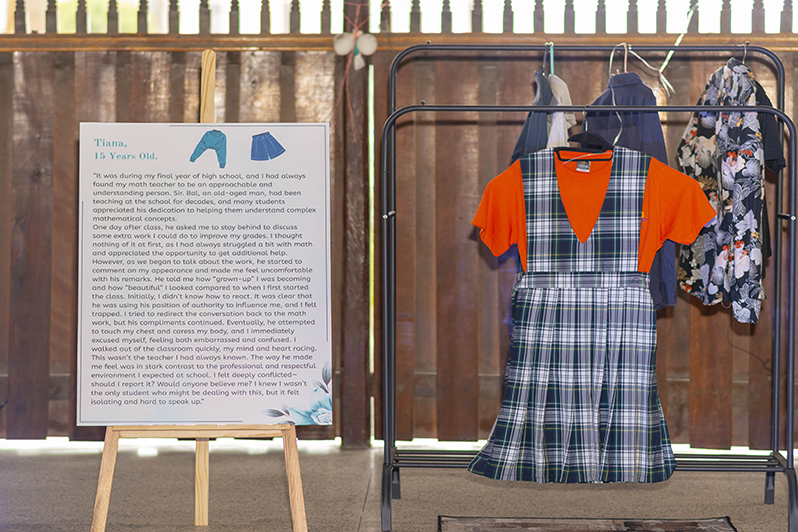Challenging the victim-blaming narrative through a powerful exhibition
FROM school uniforms and scrubs to nightgowns and children’s clothes, each piece at the ‘Asking for It’ Exhibition tells a story and, for most people, elicits strong emotions. Hosted at the Umana Yana, the exhibition is a collaborative effort between the Ministry of Human Services and Social Security and the non-profit organization, the Imperial House. Drawing inspiration from the ‘What Were You Wearing?’ exhibitions in countries like the United States and the United Kingdom, ‘Asking for It’ features the stories of sexual assault survivors, accompanied by the articles of clothing they were wearing at the time.
A first of its kind, the ‘Asking for It’ exhibition seeks to boldly highlight the prevalence of victim-blaming within our society, particularly in Guyana. Running from April 1 to 7, the exhibition features a total of 12 survivor stories and five excerpts on the laws surrounding sexual assault and rape. By showcasing the experiences of women and girls, some as young as seven years old, the exhibition aims to leave visitors unsettled and reflecting on the critical question: Is anyone who is abused ever truly ‘asking for it’?

Concept and Development of the “Asking for It” Exhibition
Social Development Director of the Imperial House, Jairo Rodrigues, shared in a talk with Pepperpot Magazine about the exhibition’s origins and the importance of bringing this conversation to Guyana. “So for ‘Asking for It,’ I wrote the concept, I designed the programme, I reached out to partners—being the Ministry of Human Services—and together we hosted the exhibition,” he shared. The idea was inspired by similar exhibitions in the U.S. and the U.K. that aimed to challenge victim-blaming narratives. His experience studying in the U.K. further reinforced the need for such an initiative in Guyana. “And when I was in the U.K. studying for my Master’s, there were a lot of campaigns about sexual assault, particularly warning students about the dangers. And I’m like, you know, we don’t have that at all back home,” he stated.
Recognising the urgency of the issue, Jairo pushed for the exhibition’s launch, seeing how the idea could be applicable to Guyana. As he shared, “After that experience, I went to the directors and I’m like, we need to fast-track this exhibit. April is coming up, April is Sexual Assault Awareness Month. So from then, we started working on putting the exhibit together, which involved collecting more stories from candidates in our programmes. We had a public call and also gathered experiences from the ministry’s 914 hotline number,” he shared.
The reality of sexual harassment and victim-blaming culture
The exhibition sheds light on the deeply ingrained culture of victim-blaming, which is all too common in Guyana. As Jairo shared, a particular incident that happened during a workshop further inspired both him and the Imperial House to make the project a reality. “In one of our programmes, one of our candidates came to me, and she was in tears,” Jairo recounted. “She was in a bus on her way to the programme and a man kept touching her. And she was vocal about it, as we taught them to be: ‘Please stop it. I don’t feel comfortable. Please keep your hand to yourself,’” he said.
However, the response—or lack thereof—from the other passengers was just as disturbing. “But what hurt her the most was no one in the bus said anything to defend or protect her. And it was a bus with a lot of women in it,” he said. Even worse, when she confided in a friend about the incident, she was met with blame rather than support. “Weeks later, she confided in a friend. And the very first thing the friend asked was, ‘What were you wearing? What did you do that made this man want to do this? What was so inviting?’” he stated.
This response reinforced the harmful narrative that survivors are somehow responsible for the violence inflicted upon them. “So again, the conversation now has to do with public discourse, which is, we need to stop blaming people for their experiences of sexual assault and rape. We need to dispel victim-blaming. And you see it all the time,” he said. Jairo also believes that men should not be left out of this conversation, saying that young men and boys too have a role to play in deconstructing the idea of victim-blaming.

The exhibition’s impact and the survivors’ stories
The stories featured in the exhibition were gathered with the full consent of the survivors, with careful consideration of how their narratives would be shared. “For us, on our public drive to our members’ partners—well, basically the public—there was a specific question to describe in detail what you were wearing,” Jairo shared. He emphasised that a great deal of care was taken in handling these sensitive stories. Many of the names have been changed to protect the survivors, and Jairo and the Imperial House worked alongside survivors in skillfully and artistically recreating the clothes featured in the displays.
One of the most striking aspects of the exhibition for visitors is the presence of school uniforms on display, highlighting the unique trauma faced by young survivors. As Jairo shared, “Anytime someone is sexually assaulted in the clothing they’re wearing, their instinct is to throw it out or to burn it. If someone’s been raped, their instinct is to go shower, bathe, and they cry and they cry and they just discard those clothes,” he said. He further added, “Girls who were in uniform—and school-age girls—do not have that option.” This daily confrontation with trauma is a stark reality for many survivors, one that the exhibition powerfully illustrates.
The ‘Asking for It’ exhibition serves as both a powerful statement and a call to action, challenging societal norms and urging visitors to rethink the narratives around sexual violence. By amplifying the voices of survivors and shedding light on the pervasiveness of victim-blaming, the exhibition is a step toward changing the conversation and fostering a culture of support rather than scrutiny.



.jpg)








